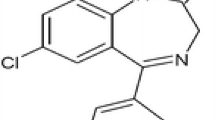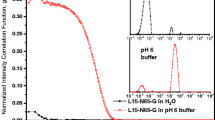Abstract
AB-type amphiphilic copolymers (abbreviated as LE) composed of poly (L-leucine) (PLL) as the A component and poly (ethylene oxide) (PEO) as the B component were synthesized by the ring-opening polymerization of L-leucine N-carboxy-anhydride initiated by methoxy polyoxyethylene amine (Me-PEO-NH2) and characterized. Core-shell type nanoparticles were prepared by the diafiltration method. Particle size distribution obtained by dynamic light scattering was dependent on PLL composition and the size for LE-1, LE-2 and LE-3 was 369.6±267, 523.4±410 and 561.2±364 nm, respectively. Shapes of the nanoparticles observed by transmission electron microscope (TEM) were almostly spherical. The critical micelle concentration (CMC) of the nanoparticles determined by a fluorescence probe technique was dependent on the composition of hydrophobic PLL, and the CMC for LE-1, LE-2 and LE-3 was 2. 0×10−6, 1.7×10−6 and 1.5×10−6 (mol/l), respectively. Clonazepam release from core-shell type nanoparticles in vitro was dependent on PLL composition and drug loading content.
Similar content being viewed by others
References Cited
Allemann, E., Gurny, R. and Doelker, E., Drug-loaded nanoparticles-preparation methods and drug targeting issues.Eur. J. Pharm. Biopharm., 39, 173–191 (1993).
Kreuter, J., Nanoparticle-based drug delivery systems.J. Control. Rel., 16, 169–176 (1991).
Porter, C. J. H., Moghimi, S. M., Illum, L. and Davis, S. S., The polyoxtethylene/polyoxyprophylene block copolymer poloxamer-407 selectivity redirects intravenously injected microsperes to sinusoidal endothelial cells of rabbit bone marrow.FEBS Let., 305, 62–66 (1992).
Couvreur, P., Fattal, E., Alphandary, H., Puisieux, F. and Andremont, A., Intracellular targeting of antibiotics by means of biodegradable nanoparticles.J. Contr. Rel., 19, 259–268 (1992).
Kwon, G. S., Naito, M., Yokoyama, M., okano, T., Sakurai, Y. and Kataoka, K., Physical entrapment of adriamycin in AB block copolymer micelles.Pharm. Res., 12, 192–195 (1995).
Hashida, M. and Takakura, Y., Phamacokinetics in design of polymeric drug delivery systems.J. Control. Rel., 31, 163–171 (1995).
Gref, R., Minamitake, Y., Peracchia, M. T., Trubetskoy, V., Torchilin, V. and Langer, R., Biodegradable longcirculating polymeric nanospheres.Science, 263, 1600–1603 (1994).
Yokoyama, Y., Kwon, G. S., Okano, Y., Sakurai, Y. and Kataoka, K.,Micelle-Forming Polymeric Drug, Chap. 10, American chemical society, 131–133 (1994).
Kuroyanagi, Y., Kim, E. and Shioya, N., Evaluation of a synthetic wound dressing capable of releasing silver sulfadiazine.J. Burn Care & Rehabilitation, 12, 106–121 (1991).
Edward, W., Merrill and Edwin, W., Polyethylene oxide as a biomaterial.Am. Soc. Art. Int. Org., 6, 60–64 (1983).
Jeon, S. I., Lee, J. H., Andrade, J. D. and De, Gennes, P. G., Protein-surface interactions in the presence of polyethylene oxide. J. Colloid.Interface Sci., 142, 149–166 (1991).
Verrecchia, T., Spenlehauer, G., Bazile, D. V., Murry-Brelier, A., Archimbaud, Y. and Veillard, M., Non-stealth(poly(lactic acid/albumin)) and stealth(poly (lactic acid-polyethylene glycol)) nanoparticles as injectable drug carriers.J. Control. Rel., 36, 49–61 (1995).
Courtney, J. M., Lamba, N. M. K., Sundaram, S. and Forbes, C. D., Biomarteials for blood-contacting applications.Biomaterials, 15, 737–744 (1994).
Cho, C. S., Kim, S. W. and Komoto, T., Synthesis and structural study of an ABA block copolymer consisting of poly(γ-benzyl L-glutamate) as the A block and poly(ethylene oxide) as the B block.Macromol. Chem., 191, 981–991 (1990).
Cho, C. S., Jo, B. W., Kwon, J. K. and Komoto, T., Synthesis and structural study of an ABA block copolymer consisting of poly(ɛ-benzyloxycarbonyl L-lysine) as the A block and poly(ethylene oxide) as the B block.Macromol. Chem. Phys., 195, 2195–2206 (1994).
Lasic, D. D., Mixed micelles in drug delivery.Nature, 355, 279–280 (1992).
Goodman, M. and Hutchison, J., The mechanisms of polymerization of N-unsubstituted N-carboxyanhydride.J. Am. Chem. Soc., 88, 3627–3630 (1966).
Cho, C. S., Na, J. W., Jeong, Y. I., Kim, S. H., Lee, Y. M., and Sung, Y. K., Micelle formation of the hexablock copolymer consisting of poly poly(γ-benzyl L-glutamate) as the hydrophobic part and poly(ethylene oxide) as the hydrophilic part.Polymer (Korea), 19, 926–931 (1995).
Wilhelm, M., Zhao, C. L., Wang, Y., Xu, R., Winnik, M. A., Mura, J. L., Riess, G. and Croucher, M. D., Poly(styrene-ethylene oxide) block copolymer micelle formation in water: A fluorescence probe study.Macromolecules, 124, 1033–1040 (1991).
Marctic, P. A. and Nair, M., Microenviroment sensing of block copolymer micelles by fluorescence spectroscopy.J. Colloids Interface Sci., 163, 517–519 (1994).
Vagberg, L. J. M., Cogan, K. A. and Gast, A. P., Light-scattering study of starlike polymeric micelles.Macromolecules, 24, 1670–1677 (1991).
Xu, R., Winnik, M. A., Hallett, F. R., Riess, G. and Croucher, M. O., Light-scattering study of the association behavior of styrene-ethylene oxide block copolymers in aqueous solution.Macromolecules, 24, 87–93 (1991).
Author information
Authors and Affiliations
Rights and permissions
About this article
Cite this article
Kim, HJ., Jeong, YI., Kim, SH. et al. Clonazepam release from core-shell type nanoparticlesin vitro . Arch. Pharm. Res. 20, 324–329 (1997). https://doi.org/10.1007/BF02976194
Received:
Issue Date:
DOI: https://doi.org/10.1007/BF02976194




